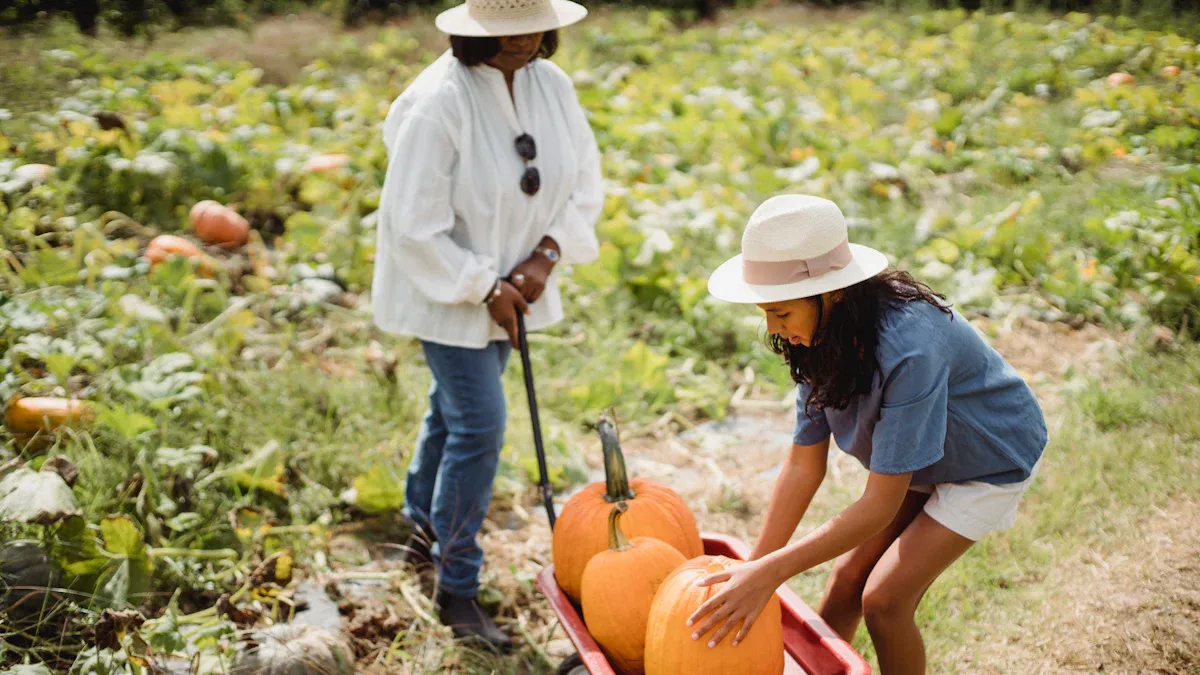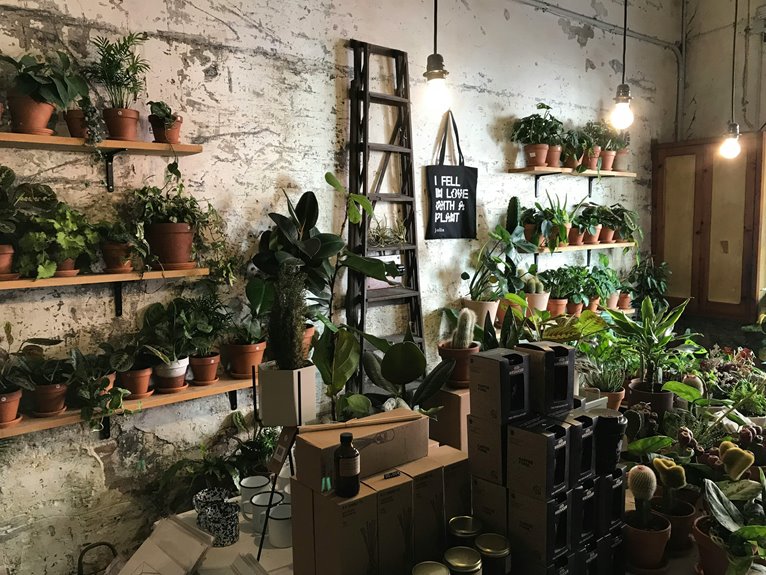
Harvesting pumpkins at the right time is crucial for quality and usability. When you pick them too early, they lack flavor and can spoil faster. Studies show that properly matured pumpkins not only taste better but also last longer in storage. So, knowing when to harvest pumpkins can make all the difference!
Key Takeaways
Harvest pumpkins when their foliage turns yellow and the tendrils are dry. This indicates they are ready for picking.
Look for deep color and a hard stem. A hollow sound when tapped means the pumpkin is ripe and ready to be harvested.
Cure your pumpkins in a warm, dry place for 10-14 days after harvesting. This helps improve their flavor and storage life.
Signs to Harvest Pumpkins

When it comes to harvesting pumpkins, you want to look for specific signs that indicate they’re ready. Two key factors to consider are the condition of the foliage and the color and size of the pumpkins themselves.
Foliage Condition
The leaves and stems of your pumpkin plants can tell you a lot about their readiness for harvest. Here are some signs to watch for:
Color Change: As pumpkins mature, their foliage often turns yellow and begins to die back. This is a natural part of the ripening process.
Dry Tendrils: Check the tendrils near the stem. If they’re dry and brown, that’s a good sign your pumpkins are ready to be picked.
Stem Hardness: When you touch the stem, it should feel hard. A soft stem indicates that the pumpkin is still growing and not ready for harvest.
Remember, if the foliage is still lush and green, it’s best to wait a bit longer before harvesting.
Color and Size
The color and size of your pumpkins are also crucial indicators of ripeness. Here’s what to look for:
Deep Color: Mature pumpkins will have a rich, deep color. If your pumpkins are still light orange or green, they aren’t ready yet.
Visible Warts: Some varieties may develop warts as they ripen. This is a sign that they’re ready for harvest.
Size Matters: Different pumpkin varieties have different size expectations. Here’s a quick reference table for some popular types:
Pumpkin Variety | Size Range (pounds) | Maturation Time (days) |
|---|---|---|
Dickinson Pumpkin | 10 – 40 | 100 |
Gold Fever | 15 – 18 | 90 |
Gold Rush | 20 – 35 | N/A |
Howden | 18 – 26 | N/A |
Harvest Time Hybrid | 24 – 48 | 95 |
Jack O’ Lantern | N/A | 110 |
As you can see, knowing the expected size for your pumpkin variety can help you determine when to harvest pumpkins.
A good rule of thumb is to tap the pumpkin. If it sounds hollow, that’s a strong indicator that it’s ready to be picked!
By keeping an eye on these signs, you’ll ensure that your pumpkins are perfectly ripe and ready for your fall festivities.
Timing for Harvesting Pumpkins

When you think about harvesting pumpkins, timing is everything! Knowing how long it takes for your pumpkins to mature can help you plan your harvest perfectly. Let’s dive into the average days to maturity for different pumpkin varieties and the best times to plant them.
Average Days to Maturity
Different pumpkin varieties have different maturation times. Here’s a quick look at how long you can expect to wait from planting to harvest:
Pumpkin Variety | Days to Maturity |
|---|---|
Jack-o’-lantern | 100 to 120 days |
Sugar Treat | 100 to 120 days |
Dill’s Atlantic Giant | 130 to 160 days |
As you can see, some pumpkins take longer to mature than others. If you’re growing a Jack-o’-lantern, you’ll be waiting about 100 to 120 days before you can harvest pumpkins. On the other hand, if you choose the Atlantic Giant, you might need to wait up to 160 days!
Keep in mind that environmental factors can affect these timelines. Pumpkins need 75 to 120 days of frost-free weather to mature. Warm soil temperatures of at least 60 degrees Fahrenheit are essential for seed germination. Also, pumpkins require 1 to 2 inches of water each week. Too much water can lead to crop rot and mildew, while not enough can stunt growth.
Ideal Planting Times
Now that you know how long it takes for pumpkins to mature, let’s talk about when to plant them. Timing your planting correctly can make a big difference in your harvest success. Here’s a table showing the recommended planting dates for various regions:
Region | Recommended Planting Dates |
|---|---|
Northern Regions | Late May or early June |
Kentucky | Late May to mid-June |
Missouri | Around May 10 |
Ohio | Late May or early June |
Wisconsin | As early as May 15; after May 20 in central/northern areas |
Understanding your USDA Hardiness Zone is crucial for timing your pumpkin planting effectively. You should plan your planting around the last frost date in spring to avoid frost damage. Counting backward from your target harvest date helps determine the optimal planting time, typically around 90 days before Halloween.
Remember, local climate variations can also affect your planting schedule. In cooler climates, you might want to start seeds indoors in late winter or early spring. In hot areas, planting should occur in late spring and early summer to avoid the stress of mid-summer heat.
By keeping these timelines in mind, you’ll set yourself up for a successful pumpkin harvest. Timing your planting and understanding the days to maturity will help you enjoy a bountiful crop just in time for fall festivities!
Best Practices to Harvest Pumpkins
When it’s time to harvest pumpkins, having the right tools makes all the difference. Here’s what you’ll need:
Tools Needed
Sharp Knife or Pruner: Use a sharp knife, pruner, or lopper to cut the pumpkins from the vine. This helps ensure a clean cut, which is crucial for preventing damage.
Garden Lopper: A garden lopper is great for reaching those hard-to-get pumpkins. Make sure to leave about three to six inches of the stem attached.
Gloves: Wearing gloves protects your hands and helps you grip the pumpkins better.
Remember, rough handling can lead to cuts and bruises on your pumpkins. Treat them gently to keep them in top condition for storage and display.
Harvesting Techniques
Now that you have your tools ready, let’s talk about how to harvest pumpkins effectively. Here are some tips:
Choose the Right Time: Harvest pumpkins when temperatures are above 50°F. This prevents chilling injury, which can hurt their storage life.
Cut Carefully: Use your knife to slice the pumpkin stem cleanly. Leaving a 4-inch stem attached helps with the curing process.
Cure Properly: After cutting, place your pumpkins in a sunny spot with temperatures between 80 to 85°F for at least two weeks. This helps heal any wounds and boosts their sugar content.
Monitor Weather: Keep an eye on the weather. Unexpected frosts can damage your pumpkins, so harvest before the temperatures drop significantly.
By following these best practices, you’ll ensure that your pumpkins are ready for fall festivities and can be stored for longer periods.
Curing and Storing Pumpkins
Curing your pumpkins is a vital step to ensure they last through the fall and winter months. This process helps to harden the skin, heal any cuts, and concentrate the natural sugars, making your pumpkins sweeter.
Curing Process
To cure your pumpkins effectively, follow these steps:
Temperature: Keep them in a warm spot between 80-85°F.
Humidity: Aim for a relative humidity of 80-85%.
Duration: Allow them to cure for 10 to 14 days.
During this time, the skin hardens, and any minor injuries begin to heal. This curing process significantly reduces spoilage risk and enhances the flavor of your pumpkins.
Remember, good air circulation is essential during curing. It helps prevent mold and ensures even drying.
Storage Tips
Once your pumpkins are cured, proper storage is key to maintaining their quality. Here are some tips to keep them fresh:
Storage Condition | Details |
|---|---|
Curing | Allow pumpkins to heal scratches for 10-14 days in a room temperature area with good air circulation. |
Temperature | Store pumpkins in a cool area, ideally between 50-55°F. |
Humidity | Keep them in a dry location to prevent rot. |
Ventilation | Ensure good airflow to reduce moisture buildup. |
Placement | Store pumpkins on hard surfaces, spaced apart to avoid contact with each other or walls. |
By following these guidelines, you can extend the shelf life of your pumpkins and enjoy them throughout the season. Remember, cooler temperatures slow down decay, while a dry environment prevents mold growth. Proper ventilation helps moisture escape, keeping your pumpkins in top shape for all your fall festivities! 🎃
Harvesting pumpkins at the right time is essential for quality and flavor. Here’s a quick recap of what you learned:
Key Aspect | Details |
|---|---|
Optimal Harvest Timing | Harvesting at the right time ensures high sugar and starch content. |
Maturity Indicators | Pumpkins may look ready but can lack flavor if picked too early. |
Recommended Harvest Time | Wait 50–55 days after pollination for the best quality. |
Curing Process | Proper curing improves storage potential and overall quality. |
By following best practices, you can boost your profits significantly. Farmers who do this see net profits ranging from $12,000 to $240,000 per patch! So, remember to care for your pumpkins well, and you’ll enjoy a bountiful harvest this fall! 🎃
FAQ
How do I know when my pumpkins are ripe?
Look for deep color, dry tendrils, and hard stems. Tap the pumpkin; a hollow sound means it’s ready!
Can I harvest pumpkins early?
Harvesting too early can lead to poor flavor and shorter shelf life. Wait until they show clear signs of ripeness.
What’s the best way to store pumpkins?
Store pumpkins in a cool, dry place with good ventilation. Aim for temperatures between 50-55°F to prolong freshness. 🎃


